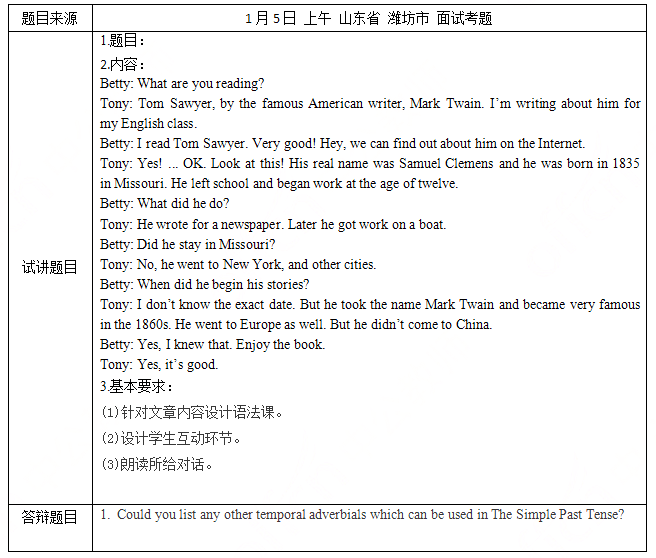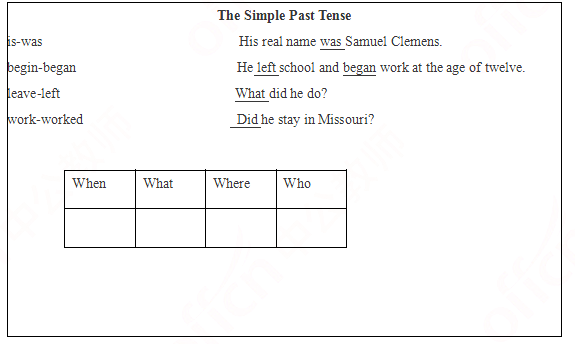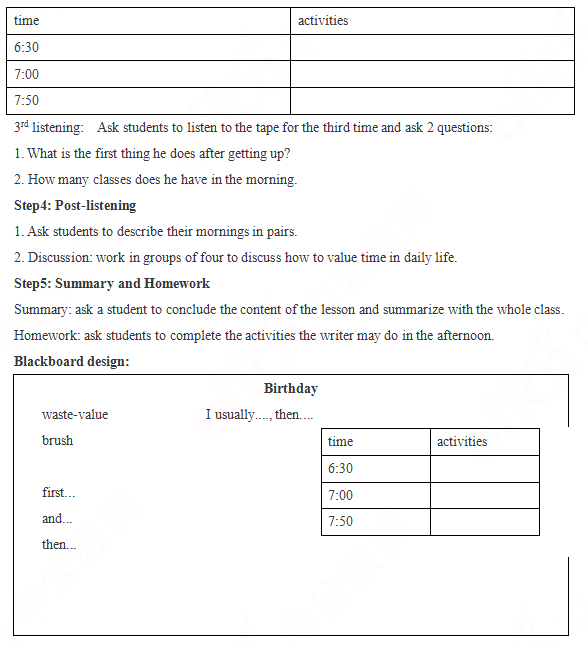What the element ‘-es’ indicates is third person singular, present tense, the element ‘-ed’ past tense, and ‘-ing’ progressive aspect. Since they are the smallest unit of language and meaningful, they are also().A、phonemesB、morphemesC、allophonesD、phones
题目
What the element ‘-es’ indicates is third person singular, present tense, the element ‘-ed’ past tense, and ‘-ing’ progressive aspect. Since they are the smallest unit of language and meaningful, they are also().
- A、phonemes
- B、morphemes
- C、allophones
- D、phones
相似考题
更多“What the element ‘-es’ indicates is third person singular, present tense, the element ‘-ed’ past tense, and ‘-ing’ progressive aspect. Since they are the smallest unit of language and meaningful, they are also().A、phonemesB、morphemesC、allophonesD、phones”相关问题
-
第1题:
Passage Five
In order to learn a foreign language well, it is necessary to overcome the fear of making mistakes. If the primary goal (目标) of language use is communication (交际), then mistakes are secondary considerations that may be dealt with gradually. On the other hand, students should not ignore their mistakes. The language learner may observe how native speakers express themselves, and how native expressions differ from the way the learner might say them. For example, a Spanish speaker who has been saying "I do it" to express willingness to do something in the immediate future, could, by communicating with native speakers of English, observe that native speakers actually say "I'll do it". The result can serve as a basis for the student to change his way of using the present tense in English. But a student who is unwilling to communicate in the first place would lose this opportunity to learn by trial and error.
52. According to the passage, the present tense in English is ______.
A. not used to express one's readiness to do something in the immediate future
B. used with some verbs but not with others to express future intention
C. basically the same in English as it is in Spanish
D. not the most difficult problem for foreign students
正确答案:A
52.答案为A 此考题为细节题。根据文章中的...a Spanish speaker who has been saying“I do it”to express willingness to do something in the immediate future,could,by communicating with native speakers of English,observe that native,speakers actually say“I'll do it”,可肯定A正确。 -
第2题:
Think about when a teacher handed out a list of twenty"Past tense"sentences and asked students to discussand find out the grammatical structures.What is the teacher's grammar teaching method?A.Induction.
B.Presentation.
C.Consolidation.
D.Deduction.答案:A解析:考查教学法辨析。题目问的是:一位老师列出了二十个与过去时相关的句子.然后请学生讨论并找出过去时的语法结构.这位老师使用了哪种语法教学方法,”语法教学的常用方法有两种演绎法和归纳法:A项的Induction是归纳法;D项的Deduction是演绎法。本题中的教学方法很明显是归纳法。B项的新课展示和C项的巩固提高,都是教学环节,不是教学方法。因此选A项,、 -
第3题:
小学英语?语法
一、考题回顾

二、考题解析
【教案】
Teaching aims:
Knowledge aim:
Students will grasp the usage of simple past tense.
Ability aim:
Students will improve their speaking ability in describing things happened in the past.
Emotional aim:
Students will be more confident in speaking English.
Students will arouse their interest in learning oral English.
Key and difficult point:
Key Point:
Students will grasp the usage of simple past tense.
Students will improve their speaking ability in describing things happened in the past.
Difficult Point:
Students will be more confident in speaking English.
Students will arouse their interest in learning oral English.
Teaching procedure:
Step 1: Warming-up
1. Greetings. Talk about the weather.
2. Sing a song called Yesterday Once More, and introduce today’s topic.
Step 2: Presentation
1. Read the dialogue by the teacher, and ask what the dialogue is about.
2. Let the students open the book and read it for the second time, then ask the students to circle the verb in it and ask the similarities among them. They may say that they are different from the verbs they learned. “-ed” is added in some verbs at the end.
3. Tell them that simple past tense is a tense that is used to describe things happened in the past. When we apply it, you should change the verb into past tense. Then introduce the regular and irregular verbs.
Step 3: Practice
1. Fill in the blanks.
a. I _____(clean) the table after we had lunch last evening.
b. My father_____(go) to the company yesterday.
Step 4: Production
1. Make a dialogue with their deskmates about what the students did last weekend. Then invite some students to share their dialogue with their parents.
2. Ask the students to make up a simple story or a joke. Then invite some students to share it with us.
Step5: Summary and Homework
Summary: make a brief summary of what we have learned today.
Homework: Tell the story or the joke to their parents.
Blackboard design:

1. Please talk about your understanding of simple past tense.
2. How do you stimulate students’ interest in learning grammar?答案:解析:1.
Simple past tense is a tense used to describe things happened in the past. When we use it, we need to change the verb into past tense. The verbs are changed in regular form or regular form. Regular verb only needs to add -ed at the end of a word, while irregular verbs have various forms. I will now show an example: My friend looked at me when I touched him. So that’s my understanding of simple past tense.
2.
Grammar can be a little boring for students. But it is essential to learn English. So different activities can be arranged to attract their attention. For example, in the warming-up, I sang a song called Yesterday Once More so that they will know this grammar point is around us and frequently used. Then, in the presentation part, I will let the students take the initiative to find the rules of simple past tense. At last, I asked students to talk about their daily lives and share stories or jokes with simple past tense, so they will use the tense and do not get bored with much mechanical drilling. So I believe they will be interested in my grammar lesson. -
第4题:
初中英语?语法
一、考题回顾

二、考题解析
【教案】
Teaching aims:
Knowledge aim:
Students will master the rule of the Simple Past Tense.
Ability aim:
Students will able to talk about the things happened in the past in their daily life.
Emotional aim:
Students will learn how to cooperate with others.
Key and difficult point:
Key Point: Students will master the structure of the Simple Past Tense.
Difficult Point: Students will use the structure of the Simple Past Tense in daily life.
Teaching procedure:
Step 1: Warming-up
1. Greetings.
2. Ask students a question: what are you reading recently? And ask some students to share with the whole class.
Step 2: Presentation
1. Review the knowledge about the past tense of verbs: write some verbs on the blackboard and ask students to change the verbs into their past tense.
2. Ask students to read the dialogue and pay attention to the background information about Mark Twain. Then ask students some questions: What’ Mark Twain’ real name? When did he born? When did he begin to work? And then invite some students to share the answers with the whole class and write down on the blackboard.
3. Then ask students when these things happened and then tell them the rule of past tense: Simple Past Tense refers to the actions or states happened at a certain moment in the past, or a certain period of time in the past. It is often used with temporal adverbial, such as yesterday, last week and so on.
4. Ask students to read the dialogue again and try to find other sentences which used the Simple Past Tense and share with class. Then tell students the rule of general and special interrogative sentences in the past tense: general interrogative sentences use auxiliary verbs (did) and special interrogative sentences use special interrogative words (what, when, how...).
Step 3: Practice
1. Ask student to role play the dialogue and ask two groups to show in class.
2. Play a game: magic box. There is a magic box which is full of all kind of verbs, ask students to choose one card and then make a sentence with it using the Simple Past Tense.
Step4: Production
Discussion: ask students to talk about what happened to them in the last weekend, they should use the Simple Past Tense and then invite two of them to show their conversation.4 in 1, 5 minutes will be given.
Step5: Summary and Homework
Summary: ask a student to conclude the content of the lesson and summarize with the whole class.
Homework: ask students to practice the usage of Simple Past Tense learned today with desk mates after class.
Blackboard design:

1. Could you list any other temporal adverbials which can be used in The Simple Past Tense?答案:解析:Usually, we can use yesterday, last night/night/month/weekend/year, the day before yesterday, in 1992 (a year in the past), in the 1990s, at the age of 16 and so on. -
第5题:
In English, long vowels are also tense vowels because when we pronounce a long vowel such as/i:/,the larynx is in a state of tension.
A对
B错
对
略 -
第6题:
What the element ‘-es’ indicates is third person singular, present tense, the element ‘-ed’ past tense, and ‘-ing’ progressive aspect. Since they are the smallest unit of language and meaningful, they are also().
Aphonemes
Bmorphemes
Callophones
Dphones
B
略 -
第7题:
在J2EE中,使用()选项中的代码,可以生成如下XML文档:
Tony Blair - A、Element people = doc.createElement("PEOPLE"); Element person = doc.createElement("PERSON"); Element name = doc.createElement("NAME"); name.appendChild(doc.createTextNode("Tony Blair")); people.appendChild(person); person.appendChild(name); doc.appendChild(people);
- B、Element people = doc.createElement("PEOPLE"); Element person = doc.createElement("PERSON"); people.appendChild(person); Element name = doc.createElement("NAME"); name.appendChild(doc.createTextNode("Tony Blair")); person.appendChild(name); doc.appendChild(people);
- C、Element people = doc.createElement("PEOPLE"); Element person = doc.createElement("PERSON"); people.appendChild(person); Element name = doc.createElement("NAME"); name.appendText(doc.createTextNode("Tony Blair")); person.appendChild(name); doc.appendChild(people);
- D、Element people = doc.createElement("PEOPLE"); Element person = doc.createElement("PERSON");Element name = doc.createElement("NAME"); name.createTextNode("Tony Blair"); people.appendChild(person); person.appendChild(name); doc.appendChild(people);
正确答案:A,B -
第8题:
What layer of the TMN (telecommunications management network) model does CTM fit into?()
- A、Network management layer
- B、Element management layer
- C、Business management layer
- D、Network element layer
正确答案:B -
第9题:
判断题In English, long vowels are also tense vowels because when we pronounce a long vowel such as/i:/,the larynx is in a state of tension.A对
B错
正确答案: 错解析: 暂无解析 -
第10题:
单选题The smallest meaningful unit of language is().Aroot
Baffix
Cstem
Dmorpheme
正确答案: C解析: 暂无解析 -
第11题:
多选题在J2EE中,使用()选项中的代码,可以生成如下XML文档: Tony BlairAElement people = doc.createElement(PEOPLE); Element person = doc.createElement(PERSON); Element name = doc.createElement(NAME); name.appendChild(doc.createTextNode(Tony Blair)); people.appendChild(person); person.appendChild(name); doc.appendChild(people);
BElement people = doc.createElement(PEOPLE); Element person = doc.createElement(PERSON); people.appendChild(person); Element name = doc.createElement(NAME); name.appendChild(doc.createTextNode(Tony Blair)); person.appendChild(name); doc.appendChild(people);
CElement people = doc.createElement(PEOPLE); Element person = doc.createElement(PERSON); people.appendChild(person); Element name = doc.createElement(NAME); name.appendText(doc.createTextNode(Tony Blair)); person.appendChild(name); doc.appendChild(people);
DElement people = doc.createElement(PEOPLE); Element person = doc.createElement(PERSON);Element name = doc.createElement(NAME); name.createTextNode(Tony Blair); people.appendChild(person); person.appendChild(name); doc.appendChild(people);
正确答案: B,D解析: 暂无解析 -
第12题:
单选题What the element ‘-es’ indicates is third person singular, present tense, the element ‘-ed’ past tense, and ‘-ing’ progressive aspect. Since they are the smallest unit of language and meaningful, they are also().Aphonemes
Bmorphemes
Callophones
Dphones
正确答案: B解析: 暂无解析 -
第13题:
A teacher showed students an example and explained the usage of past perfect tense, and asked students to list ten"past perfect tense" sentences by imitating that example. What's the teacher' s grammar teaching method?A.Consolidation.
B.Presentation.
C.Deduction.
D.Induction.答案:C解析:考查语法教学知识。教师通过一个例子讲了语法过去完成时的用法,然后让学生模仿此例子造十个过去完成时的句子,是典型的“演绎”教学法。consolidation意为“巩固”,presentation意为“呈现”,deduction意为“演绎”,induction意为“归纳”。 -
第14题:
A teacher showed students an example and explained the usage of past perfect tense,and ask students to listen“past perfect tense”sentences by imitating that example.What’s teacher's grammar teaching method?A.Consolidation.
B.Presentation.
C.Deduction.
D.Induction.答案:C解析:考查语法教学知识。
题干的意思:老师给学生展示例子和解释过去完成时的用法,让学生模仿例子列出十个过去完成时的句子,老师用的是什么教学方法?
C项,演绎法法,符合题意,故此题的正确选项为C。
A项,巩固;B项,新授;C项,归纳法,和演绎法相反;均不合题意,故排除。
故此题的正确选项为C。 -
第15题:

二、考题解析
【教案】
Teaching aims:
Knowledge aims:
Students will know how to describe a day using proper conjunctions and tense.
Students will master some words, such as waste, value... and a sentence structure: I usually + simple present tense.
Ability aim:
Students will improve their abilities of speaking and listening.
Emotional aim:
Students will be more confident in speaking English.
Key and difficult point:
Key Point: Students will know how to introduce a day in English.
Difficult Point: Students will use the sentence structure in real communicative situation.
Teaching procedure:
Step 1: Warming-up
1. Greetings.
2. Play a video about Tom’s day and ask students what kind of information have they caught.
Step 2: Pre-listening
1. Review the knowledge about simple present tense. Ask students to make sentences using simple present tense.
2.Using pictures to explain some words: waste-value, brush.
Step 3: While-listening
1st listening: Ask students to listen to the tape for the first time and try to get the main idea of the passage and underline the conjunctions used.
2nd listening: Ask students to listen to the tape for the second time and complete the timetable below.
 答案:解析:暂无解析
答案:解析:暂无解析 -
第16题:
The smallest meaningful unit of language is ( )A.phone
B.morpheme
C.phoneme
D.allomorph答案:B解析:考查语言学。题干为:语言中有意义的最小的单位是以下哪一项?词素是语言中有意义的最小单位,B项morpheme(词素)符合条件。A项phone(音素),C项phoneme(音位)和D项allomorph(语素变体)均不符合,排除。 -
第17题:
The smallest meaningful unit of language is().
Aroot
Baffix
Cstem
Dmorpheme
D
略 -
第18题:
The smallest meaningful unit of language is allomorph.
正确答案:错误 -
第19题:
In English, long vowels are also tense vowels because when we pronounce a long vowel such as/i:/,the larynx is in a state of tension.
正确答案:正确 -
第20题:
在J2EE中,假设sample.xml文档有一个元素是
,它有个子元素是 。我们已经获得了Document对象doc,取出第一个 的第一个子元素 的值的代码是()。 - A、((Element).doc.getElementsByTagName(“PERSON”).item(0)).getNodeValue;
- B、 ((Element).doc.getElementsByTagName(“PERSON”).item(0)).getFristChild().getNodeValue();
- C、 ((Element).doc.getElementsByTagName(“PERSON”).item(0)).getElementsByTagName(“NAME”).item(0).getNodeValue();
- D、 ((Element).doc.getElementsByTagName(“PERSON”).item(0)).item(0).getNodeValue();
正确答案:C -
第21题:
单选题A teacher lists twenty" simple present tense" sentences and asks students to discuss and find out the grammatical structures. What's the teacher's grammar teaching method?AInduction.
BConduction.
CConstruction.
DDeduction.
正确答案: A解析: -
第22题:
单选题_____ is the smallest meaningful unit of language.Aphoneme
Bsyllable
CMorpheme
Dvowel
正确答案: B解析:
语素是最小的语言单位,不能再进一步分成更小的单位而不破坏或彻底改变词汇意义和语法意义。 -
第23题:
判断题The smallest meaningful unit of language is allomorph.A对
B错
正确答案: 错解析: 暂无解析
